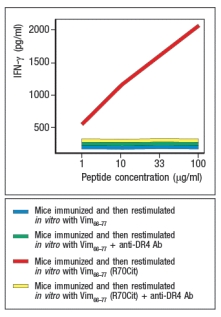During Inflammation, Some Proteins Undergo Modification, Converting Arginine Residues in Their
Essay
During inflammation, some proteins undergo modification, converting arginine residues in their sequences to citrulline. In smokers, an increased level of protein citrullination has been detected in cells of the lung, an observation that has been proposed as one explanation for the strong association between smoking and the autoimmune disease, rheumatoid arthritis. To determine a potential mechanism by which protein citrullination might lead to autoimmunity, studies were performed in mice. These mice were transgenic for the human MHC class II molecule, HLA DR4, the allele showing strong association with rheumatoid arthritis in humans. These mice were immunized with a peptide derived from the self-antigen vimentin (Vim65-77), or with a variant Vim65-77 peptide in which the arginine at position 70 of this peptide was converted to citrulline (Vim65-77(R70Cit)). Ten days later, T cells were isolated from draining lymph nodes of the immunized mice, and were stimulated in vitro with APCs plus each vimentin peptide. After three days of culture, IFN- levels in the supernatants of the cultures were measured, as shown in Figure Q1)18). To confirm that the T cell responses were directed at vimentin peptides bound to DR4, duplicate in vitro cultures received anti-DR4 blocking antibody. What hypothesis is suggested by these data to account for how protein citrullination might lead to autoimmunity? 
Correct Answer:

Verified
The citrullination of the self-peptide a...View Answer
Unlock this answer now
Get Access to more Verified Answers free of charge
Correct Answer:
Verified
View Answer
Unlock this answer now
Get Access to more Verified Answers free of charge
Q13: Multiple sclerosis is an autoimmune
Q14: Multiple mechanisms provide a series of checkpoints
Q15: 23) Multiple autoimmune diseases are associated with
Q16: All-trans retinoic acid (tRA) is a metabolite
Q17: 26) Epidemiological evidence has indicated that exposure
Q19: 22) The majority of monogenic defects in
Q20: Based on these data, Fc
Q21: In some cases, a transient autoimmune process
Q22: Polymorphisms in the IL-2R <span class="ql-formula"
Q23: Some early studies aimed at deciphering